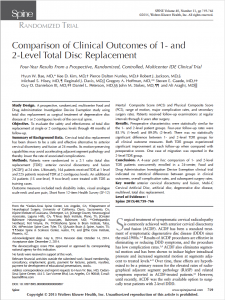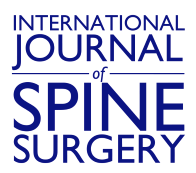
Abstract
STUDY DESIGN: A prospective, randomized, multicenter Food and Drug Administration Investigation Device Exemption study using total disc replacement as surgical treatment of degenerative disc disease at 1 or 2 contiguous levels of the cervical spine.
OBJECTIVE: To evaluate the safety and effectiveness of total disc replacement at single or 2 contiguous levels through 48 months of follow-up.
SUMMARY OF BACKGROUND DATA: Cervical total disc replacement has been shown to be a safe and effective alternative to anterior cervical discectomy and fusion at 24 months. Its motion-preserving capabilities may avoid accelerating adjacent segment pathology and thereby lower the rate of associated complications.
METHODS: Patients were randomized in a 2:1 ratio (total disc replacement [TDR]: anterior cervical discectomy and fusion [ACDF]) at 24 sites. Ultimately, 164 patients received TDR at 1 level and 225 patients received TDR at 2 contiguous levels. An additional 24 patients (15 one-level, 9 two-level) were treated with TDR as training cases.Outcome measures included neck disability index, visual analogue scale neck and arm pain, Short Form 12-item Health Survey (SF-12) Mental Composite Score (MCS) and Physical Composite Score (PCS), range of motion, major complication rates, and secondary surgery rates. Patients received follow-up examinations at regular intervals through 4 years after surgery.
RESULTS: Preoperative characteristics were statistically similar for the 1- and 2-level patient groups. Four-year follow-up rates were 83.1% (1-level) and 89.0% (2-level). There was no statistically significant difference between 1- and 2-level TDR groups for all clinical outcome measures. Both TDR groups experienced significant improvement at each follow-up when compared with preoperative scores. One case of migration was reported in the 2-level TDR group.
CONCLUSION: A 4-year post hoc comparison of 1- and 2-level TDR patients concurrently enrolled in a 24-center, Food and Drug Administration Investigation Device Exemption clinical trial indicated no statistical differences between groups in clinical outcomes, overall complication rates, and subsequent surgery rates.
To Read The Full Article Click Here
PMID: 25785955 DOI: 10.1097/BRS.0000000000000887






